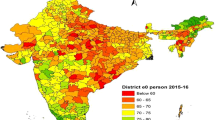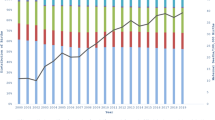Abstract
Low birth weight (LBW), defined as a live birth weighing <2,500 g, is a significant public health problem in the United States, especially a few states including Georgia. Although much work has been done to study the epidemiology of LBW in various regions, the spatial–temporal patterns of LBW prevalence in Georgia remain unclear to a large degree. This paper investigates the temporal trend of LBW rates over a time span of 11 years and the spatial clusters of LBW prevalence in the state of Georgia at the county level. Comparison is also made between race and gender groups, and between county groups of different socioeconomic statuses to uncover disparities. Results showed a steady and prevalent increase of LBW rate in the state over the study period. Three counties and two county clusters with significantly higher LBW rates than the state rate were detected for 1999–2001, while one more county and two more county clusters of high LBW rates were detected for 2007–2009. More urbanized counties were found to have a relatively lower LBW rate when compared with the less urbanized ones as groups. The findings from this paper are expected to provide valuable insights to better understanding the etiology of LBW and more effective allocating prenatal health care resources in the future.







Similar content being viewed by others
References
Adams, M. M., Sarno, A. P., Harlass, F. E., Rawlings, J. S., & Read, J. A. (1995). Risk factors for preterm delivery in a healthy cohort. Epidemiology, 6(5), 525–532.
Aguilera, I., Guxens, M., Garcia-Esteban, R., Corbella, T., Nieuwenhuijsen, M. J., Foradada, C. M., et al. (2009). Association between GIS-Based Exposure to Urban Air Pollution during Pregnancy and Birth Weight in the INMA Sabadell Cohort. Environmental health perspectives, 117(8).
Bailey, B., & Byrom, A. (2007). Factors predicting birth weight in a low-risk sample: The role of modifiable pregnancy health behaviors. Maternal and Child Health Journal, 11(2), 173–179. doi:10.1007/s10995-006-0150-7.
Buka, S. L., Brennan, R. T., Rich-Edwards, J. W., Raudenbush, S. W., & Earls, F. (2003). Neighborhood support and the birth weight of urban infants. American Journal of Epidemiology, 157(1), 1–8. doi:10.1093/aje/kwf170.
Centers for Disease Control and Prevention (CDC) (2012). Vitalstats: Birth. http://www.cdc.gov/nchs/fastats/birthwt.htm. Accessed 8 Sept 2012.
Collier, S. A., & Hogue, C. J. (2007). Modifiable risk factors for low birth weight and their effect on cerebral palsy and mental retardation. Maternal and Child Health Journal, 11(1), 65–71. doi:10.1007/s10995-006-0085-z.
Cromley, E. K., & McLafferty, S. (2002). GIS and public health. New York: Guilford Press.
Crosse, E. A., Alder, R. J., Ostbye, T., & Campbell, M. K. (1997). Small area variation in low birthweight: Looking beyond socioeconomic predictors. [Research Support, Non-U.S. Gov’t]. Canadian journal of public health. Revue canadienne de sante publique, 88(1), 57–61.
Dunlop, A., Salihu, H., Freymann, G., Smith, C., & Brann, A. (2011). Very low birth weight births in Georgia, 1994–2005: Trends and racial disparities. Maternal and Child Health Journal, 15(7), 890–898. doi:10.1007/s10995-010-0590-y.
Dwass, M. (1957). Modified randomization tests for nonparametric hypotheses. The Annals of Mathematical Statistics, 28(1), 181–187.
Elliott, P. (2000). Spatial epidemiology: Methods and applications (Oxford medical publications). Oxford: Oxford University Press.
English, P. B., Kharrazi, M., Davies, S., Scalf, R., Waller, L., & Neutra, R. (2003). Changes in the spatial pattern of low birth weight in a southern California county: The role of individual and neighborhood level factors. [Research Support, U.S. Gov’t, P.H.S.]. Social Science and Medicine, 56(10), 2073–2088.
Ensher, G. L., & Clark, D. A. (1994). Newborns at risk : Medical care and psychoeducational intervention (2nd ed.). Gaithersburg, Md.: Aspen Publishers.
Gatrell, A. C., & Rigby, J.E. (2004). Spatial perspectives in public health. In M. F. a. J. Goodchild, D.G. (Ed.), Spatially Integrated Social Science: Examples in Best Practice, pp. 366–380). New York: Oxford University Press.
Georgia Department of Public Health (GDPH) (2012). Maternal Child Health Statistics. http://oasis.state.ga.us/oasis/oasis/qryMCH.aspx. Accessed 31 Dec 2012.
Georgia Family Connection Partnership (GAFCP) (2012). Improving Infant Health. http://fcn.gafcp.org/lbw/LBWcompendium.pdf. Accessed 8 Sept 2012.
Heaman, M., Newburn-Cook, C., Green, C., Elliott, L., & Helewa, M. (2008). Inadequate prenatal care and its association with adverse pregnancy outcomes: A comparison of indices. BMC Pregnancy and Childbirth, 8(1), 15.
Hillemeier, M. M., Weisman, C. S., Chase, G. A., & Dyer, A. M. (2007). Individual and community predictors of preterm birth and low birthweight along the rural-urban continuum in central Pennsylvania. J Rural Health, 23(1), 42–48. doi:10.1111/j.1748-0361.2006.00066.x.
Hussaini, S., Holley, P., & Ritenour, D. (2011). Reducing low birth weight infancy: Assessing the effectiveness of the Health Start Program in Arizona. Maternal and Child Health Journal, 15(2), 225–233. doi:10.1007/s10995-009-0556-0.
Jason, D. B., Powers, D. A., Padilla, Y. C., & Hummer, R. A. (2002). Low birth weight, social factors, and developmental outcomes among children in the United States. Demography, 39(2), 353–368.
Kiely, J. S., K.M.Brett, S.Yu, D.L.Rowley (1994). Low birthweight and intrauterine growth retardation.
Kramer, M. S., Seguin, L., Lydon, J., & Goulet, L. (2000). Socio-economic disparities in pregnancy outcome: Why do the poor fare so poorly? Paediatric and Perinatal Epidemiology, 14(3), 194–210.
Kulldorff, M. (1997). A spatial scan statistic. Communications in Statistics—Theory and Methods, 26(6), 1481–1496. doi:10.1080/03610929708831995.
Kulldorff, M., Huang, L., & Konty, K. (2009). A scan statistic for continuous data based on the normal probability model. International Journal of Health Geographics, 8(1), 58.
Luo, Z., Wilkins, R., & Kramer, M. (2006). Effect of neighbourhood income and maternal education on birth outcomes: A population-based study. Canadian Medical Association Journal, 174, 1415–1421.
Mathews, T. J., Menacker, F., & MacDorman, M. F. (2003). Infant mortality statistics from the 2001 period linked birth/infant death data set. National Vital Statistics Reports, 52(2), 1–28.
Mervis, C. A., Decoufle, P., Murphy, C. C., & Yeargin-Allsopp, M. (1995). Low birthweight and the risk for mental retardation later in childhood. [Research Support, U.S. Gov’t, P.H.S.]. Paediatric and Perinatal Epidemiology, 9(4), 455–468.
Moore, D. A., & Carpenter, T. E. (1999). Spatial analytical methods and geographic information systems: Use in health research and epidemiology. [Review]. Epidemiologic Reviews, 21(2), 143–161.
Morello-Frosch, R., Jesdale, B., Sadd, J., & Pastor, M. (2010). Ambient air pollution exposure and full-term birth weight in California. Environmental Health, 9(1), 44.
Msall, M. E., & Tremont, M. R. (2002). Measuring functional outcomes after prematurity: Developmental impact of very low birth weight and extremely low birth weight status on childhood disability. [Research Support, Non-U.S. Gov’tResearch Support, U.S. Gov’t, P.H.S.Review]. Mental Retardation And Developmental Disabilities Research Reviews, 8(4), 258–272. doi:10.1002/mrdd.10046.
O’Campo, P., Xue, X., Wang, M. C., & Caughy, M. (1997a). Neighborhood risk factors for low birthweight in Baltimore: A multilevel analysis. American Journal of Public Health, 87(7), 1113–1118.
O’Campo, P., Xue, X., Wang, M., & O’Brien Caughy, M. (1997b). Neighborhood Risk Factors for Low Birthweight in Baltimore: A Multilevel Analysis. American Journal of Public Health, 87, 1113–1118.
Oden, N. (1995). Adjusting Moran’s I for population density. Statistics in Medicine, 14(1), 17–26. doi:10.1002/sim.4780140104.
Paneth, N. S. (1995). The problem of low birth weight. Future of Children, 5(1), 19–34.
Rantakallio, P., & von Wendt, L. (1985). Prognosis for low-birthweight infants up to the age of 14: A population study. [Research Support, Non-U.S. Gov’t]. Developmental Medicine and Child Neurology, 27(5), 655–663.
Reichman, N. E., & Teitler, J. O. (2005). Timing of enhanced prenatal care and birth outcomes in New Jersey’s healthstart program. Maternal and Child Health Journal, 9(2), 151–158. doi:10.1007/s10995-005-4905-3.
Robinson, N. M., & Robinson, H. B. (1965). A follow-up study of children of low birth weight and control children at school age. Pediatrics, 35, 425–433.
Rogers, J. F., & Dunlop, A. L. (2006). Air pollution and very low birth weight infants: A target population? Pediatrics, 118(1), 156–164. doi:10.1542/peds.2005-2432.
Rogers, J. F., Thompson, S. J., Addy, C. L., McKeown, R. E., Cowen, D. J., & Decouflé, P. (2000). Association of very low birth weight with exposures to environmental sulfur dioxide and total suspended particulates. American Journal of Epidemiology, 151(6), 602–613.
Sellström, E., & Bremberg, S. (2006). Review Article: The significance of neighbourhood context to child and adolescent health and well-being: A systematic review of multilevel studies. Scandinavian Journal of Public Health, 34(5), 544–554. doi:10.1080/14034940600551251.
Stein, A., Campbell, E., Day, A., McPhearson, K., & Cooper, P. (1987). Social adversity, low birth weight, and preterm delivery. British Medical Journal, 295, 291–293.
Tu, W., Tedders, S., & Tian, J. (2012). An exploratory spatial data analysis of low birth weight prevalence in Georgia. Applied Geography, 32(2), 195–207.
United Nations (2012). The Millennium Development Goals Report http://www.un.org/millenniumgoals/pdf/MDG_Report_2009_ENG.pdf. Accessed 8 Sept 2012.
U.S. Department of Health and Human Services (USDHHS) (2010). Healthy People 2020. http://www.healthypeople.gov/2020/topicsobjectives2020/default.aspx. Accessed Sept 8 2012.
Wilcox, A. J., & Russell, I. T. (1983). Perinatal mortality: Standardizing for birthweight is biased. American Journal of Epidemiology, 118(6), 857–864.
Young, R., Weinberg, J., Vieira, V., Aschengrau, A., & Webster, T. (2010). A multilevel non-hierarchical study of birth weight and socioeconomic status. International Journal of Health Geographics, 9(1), 36.
Author information
Authors and Affiliations
Corresponding author
Rights and permissions
About this article
Cite this article
Tian, J., Tu, W., Tedders, S. et al. A spatial–temporal analysis of low birth weight prevalence in Georgia, USA. GeoJournal 78, 885–895 (2013). https://doi.org/10.1007/s10708-013-9472-3
Published:
Issue Date:
DOI: https://doi.org/10.1007/s10708-013-9472-3




